The Determination of the Snow Optical Grain Diameter and Snowmelt Area on the Greenland Ice Sheet Using Spaceborne Optical Observations
Abstract
1. Introduction
2. Methods
2.1. OLCI Instrument and Data Pre-Processing
2.2. Cloud Identification
2.3. Mosaic Construction
2.4. The SICE Retrieval of Snow Albedo and Optical Grain Size
2.5. Comparison with Ground Optical Measurements of Snow Grain Diameter
2.6. Surface Melt and Snowfall Detection
2.6.1. Automatic Weather Station Data and Surface Energy Balance Modelling
2.6.2. Passive Microwave Remote Sensing of Surface Melt and Melt Flag Comparison
3. Results
3.1. Evaluation of the Grain Size Rretrieval
3.2. The SICE Snow Optical Grain Diameter Dataset
3.3. Optical Grain Diameter as an Indicator of Melt Affected Snow
3.4. Application to a Heat Wave in Northeast Greenland and Comparison to the MEaSUREs Melt Flag
4. Discussion
5. Conclusions
Supplementary Materials
Author Contributions
Funding
Data Availability Statement
Acknowledgments
Conflicts of Interest
References
- Flanner, M.G.; Shell, K.M.; Barlage, M.; Perovich, D.K.; Tschudi, M.A. Radiative forcing and albedo feedback from the Northern Hemisphere cryosphere between 1979 and 2008. Nat. Geosci. 2011, 4, 151–155. [Google Scholar] [CrossRef]
- Van Den Broeke, M.R.; Enderlin, E.M.; Howat, I.M.; Kuipers Munneke, P.; Noël, B.P.Y.; Jan Van De Berg, W.; Van Meijgaard, E.; Wouters, B. On the recent contribution of the Greenland ice sheet to sea level change. Cryosphere 2016, 10, 1933–1946. [Google Scholar] [CrossRef]
- Fettweis, X.; Box, J.E.; Agosta, C.; Amory, C.; Kittel, C.; Lang, C.; Van As, D.; Machguth, H.; Gallée, H. Reconstructions of the 1900–2015 Greenland ice sheet surface mass balance using the regional climate MAR model. Cryosphere 2017, 11, 1015–1033. [Google Scholar] [CrossRef]
- Noël, B.; van de Berg, W.J.; Lhermitte, S.; van den Broeke, M.R. Rapid ablation zone expansion amplifies north Greenland mass loss. Sci. Adv. 2019, 5, 2–11. [Google Scholar] [CrossRef] [PubMed]
- Ryan, J.C.; Smith, L.C.; As, D.V.; Cooley, S.W.; Cooper, M.G.; Pitcher, L.H.; Hubbard, A. Greenland Ice Sheet surface melt amplified by snowline migration and bare ice exposure. Sci. Adv. 2019, 5, eaav3738. [Google Scholar] [CrossRef]
- Wehrlé, A.; Box, J.E.; Niwano, M.; Anesio, A.M.; Fausto, R.S. Greenland bare-ice albedo from promice automatic weather station measurements and sentinel-3 satellite observations. Geol. Surv. Den. Greenl. Bull. 2021, 47. [Google Scholar] [CrossRef]
- Wang, W.; Zender, C.S.; van As, D.; Fausto, R.S.; Laffin, M.K. Greenland Surface Melt Dominated by Solar and Sensible Heating. Geophys. Res. Lett. 2021, 48, e2020GL090653. [Google Scholar] [CrossRef]
- Warren, S.G.; Wiscombe, W.J. A model for the spectral albedo of snow. II: Snow containing atmospheric aerosols. J. Atmos. Sci. 1980, 37, 2734–2745. [Google Scholar] [CrossRef]
- Wiscombe, W.J.; Warren, S.G. A model for the spectral albedo of snow. I: Pure snow. J. Atmos. Sci. 1980, 37, 2712–2733. [Google Scholar] [CrossRef]
- Gardner, A.S.; Sharp, M.J. A review of snow and ice albedo and the development of a new physically based broadband albedo parameterization. J. Geophys. Res. Earth Surf. 2010, 115, F01009. [Google Scholar] [CrossRef]
- Dumont, M.; Brun, E.; Picard, G.; Michou, M.; Libois, Q.; Petit, J.R.; Geyer, M.; Morin, S.; Josse, B. Contribution of light-absorbing impurities in snow to Greenland’s darkening since 2009. Nat. Geosci. 2014, 7, 509–512. [Google Scholar] [CrossRef]
- Mote, T.L. Greenland surface melt trends 1973–2007: Evidence of a large increase in 2007. Geophys. Res. Lett. 2007, 34, L22507. [Google Scholar] [CrossRef]
- Houtz, D.; Naderpour, R.; Schwank, M.; Steffen, K. Snow wetness and density retrieved from L-band satellite radiometer observations over a site in the West Greenland ablation zone. Remote Sens. Environ. 2019, 235, 111361. [Google Scholar] [CrossRef]
- Abdalati, W.; Steffen, K. Accumulation and hoar effects on microwave emission in the Greenland ice-sheet dry-snow zones. J. Glaciol. 1998, 44, 523–531. [Google Scholar] [CrossRef][Green Version]
- Smith, B.E.; Gardner, A.; Schneider, A.; Flanner, M. Modeling biases in laser-altimetry measurements caused by scattering of green light in snow. Remote Sens. Environ. 2018, 215, 398–410. [Google Scholar] [CrossRef]
- Davis, C.H.; Zwally, H.J. Geographic and seasonal variations in the surface properties of the ice sheets by satellite-radar altimetry. J. Glaciol. 1993, 39, 687–697. [Google Scholar] [CrossRef]
- Larue, F.; Picard, G.; Aublanc, J.; Arnaud, L.; Robledano-Perez, A.; LE Meur, E.; Favier, V.; Jourdain, B.; Savarino, J.; Thibaut, P. Radar altimeter waveform simulations in Antarctica with the Snow Microwave Radiative Transfer Model (SMRT). Remote Sens. Environ. 2021, 263, 112534. [Google Scholar] [CrossRef]
- Verjans, V.; Leeson, A.A.; Max Stevens, C.; MacFerrin, M.; Noël, B.; Van Den Broeke, M.R. Development of physically based liquid water schemes for Greenland firn-densification models. Cryosphere 2019, 13, 1819–1842. [Google Scholar] [CrossRef]
- Fily, M.; Bourdelles, B.; Dedieu, J.P.; Sergent, C. Comparison of In situ and Landsat thematic mapper derive snow grain characteristics in the Alps. Remote Sens. Environ. 1997, 59, 452–460. [Google Scholar] [CrossRef]
- Fierz, C.; Armstrong, R.L.R.L.; Durand, Y.; Etchevers, P.; Greene, E.; McClung, D.M.D.M.; Nishimura, K.; Satyawali, P.K.; Sokratov, S.A. The International Classification for Seasonal Snow on the Ground. IHP-VII Tech. Doc. Hydrol. 2009, 83, 90. [Google Scholar]
- Aoki, T.; Hori, M.; Motoyoshi, H.; Tanikawa, T.; Hachikubo, A.; Sugiura, K.; Yasunari, T.J.; Storvold, R.; Eide, H.A.; Stamnes, K.; et al. ADEOS-II/GLI snow/ice products—Part II: Validation results using GLI and MODIS data. Remote Sens. Environ. 2007, 111, 274–290. [Google Scholar] [CrossRef]
- Grenfell, T.C.; Perovich, D.K.; Ogren, J.A. Spectral albedos of an alpine snowpack. Cold Reg. Sci. Technol. 1981, 4, 121–127. [Google Scholar] [CrossRef]
- Warren, S.G. Optical properties of snow. Rev. Geophys. 1982, 20, 67–89. [Google Scholar] [CrossRef]
- Lyapustin, A.; Tedesco, M.; Wang, Y.; Aoki, T.; Hori, M.; Kokhanovsky, A. Retrieval of snow grain size over Greenland from MODIS. Remote Sens. Environ. 2009, 113, 1976–1987. [Google Scholar] [CrossRef]
- Carlsen, T.; Birnbaum, G.; Ehrlich, A.; Freitag, J.; Heygster, G.; Istomina, L.; Kipfstuhl, S.; Orsi, A.; Schäfer, M.; Wendisch, M. Comparison of different methods to retrieve effective snow grain size in central Antarctica. Cryosphere Discuss. 2017, 6, 1–20. [Google Scholar] [CrossRef]
- Carmagnola, C.M.; Morin, S.; Lafaysse, M.; Domine, F.; Lesaffre, B.; Lejeune, Y.; Picard, G.; Arnaud, L. Implementation and evaluation of prognostic representations of the optical diameter of snow in the SURFEX/ISBA-Crocus detailed snowpack model. Cryosphere 2014, 8, 417–437. [Google Scholar] [CrossRef]
- Brun, E. Investigation on wet-snow metamorphism in respect of liquid-water content. Ann. Glaciol. 1989, 13, 22–26. [Google Scholar] [CrossRef]
- Domine, F.; Taillandier, A.S.; Cabanes, A.; Douglas, T.A.; Sturm, M. Three examples where the specific surface area of snow increased over time. Cryosphere 2009, 3, 31–39. [Google Scholar] [CrossRef]
- Xiong, C.; Shi, J. Snow specific surface area remote sensing retrieval using a microstructure based reflectance model. Remote Sens. Environ. 2018, 204, 838–849. [Google Scholar] [CrossRef]
- Mary, A.; Dumont, M.; Dedieu, J.-P.; Durand, Y.; Sirguey, P.; Milhem, H.; Mestre, O.; Negi, H.S.; Kokhanovsky, A.A.; Lafaysse, M.; et al. Intercomparison of retrieval algorithms for the specific surface area of snow from near-infrared satellite data in mountainous terrain, and comparison with the output of a semi-distributed snowpack model. Cryosphere 2013, 7, 741–761. [Google Scholar] [CrossRef]
- Dozier, J.; Schneider, S.R.; McGinnis, D.F. Effect of grain size and snowpack water equivalence on visible and near-infrared satellite observations of snow. Water Resour. Res. 1981, 17, 1213–1221. [Google Scholar] [CrossRef]
- Dozier, J. Spectral signature of alpine snow cover from the landsat thematic mapper. Remote Sens. Environ. 1989, 28, 9–22. [Google Scholar] [CrossRef]
- Bourdelles, B.; Fily, M. Snow grain-size determination from Landsat imagery over Terre Adelie, Antarctica. Ann. Glaciol. 1993, 17, 1723–1738. [Google Scholar] [CrossRef][Green Version]
- Painter, T.H.; Rittger, K.; McKenzie, C.; Slaughter, P.; Davis, R.E.; Dozier, J. Retrieval of subpixel snow covered area, grain size, and albedo from MODIS. Remote Sens. Environ. 2009, 113, 868–879. [Google Scholar] [CrossRef]
- Stamnes, K.; Li, W.; Eide, H.; Aoki, T.; Hori, M.; Storvold, R. ADEOS-II/GLI snow/ice products—Part I: Scientific basis. Remote Sens. Environ. 2007, 111, 258–273. [Google Scholar] [CrossRef]
- Hori, M.; Aoki, T.; Stamnes, K.; Li, W. ADEOS-II/GLI snow/ice products—Part III: Retrieved results. Remote Sens. Environ. 2007, 111, 291–336. [Google Scholar] [CrossRef]
- Grenfell, T.C.; Warren, S.G. Representation of a nonspherical ice particle by a collection of independent spheres for scattering and absorption of radiation. J. Geophys. Res. Atmos. 1999, 104, 31697–31709. [Google Scholar] [CrossRef]
- Jin, Z.; Charlock, T.P.; Yang, P.; Xie, Y.; Miller, W. Snow optical properties for different particle shapes with application to snow grain size retrieval and MODIS/CERES radiance comparison over Antarctica. Remote Sens. Environ. 2008, 112, 3563–3581. [Google Scholar] [CrossRef]
- Zege, E.P.; Katsev, I.L.; Malinka, A.V.; Prikhach, A.S.; Heygster, G.; Wiebe, H. Algorithm for retrieval of the effective snow grain size and pollution amount from satellite measurements. Remote Sens. Environ. 2011, 115, 2674–2685. [Google Scholar] [CrossRef]
- Libois, Q.; Picard, G.; France, J.L.; Arnaud, L.; Dumont, M.; Carmagnola, C.M.; King, M.D. Influence of grain shape on light penetration in snow. Cryosphere 2013, 7, 1803–1818. [Google Scholar] [CrossRef]
- Yang, Y.; Marshak, A.; Han, M.; Palm, S.P.; Harding, D.J. Snow grain size retrieval over the polar ice sheets with the Ice, Cloud, and land Elevation Satellite (ICESat) observations. J. Quant. Spectrosc. Radiat. Transf. 2017, 188, 159–164. [Google Scholar] [CrossRef]
- Tanikawa, T.; Kuchiki, K.; Aoki, T.; Ishimoto, H.; Hachikubo, A.; Niwano, M.; Hosaka, M.; Matoba, S.; Kodama, Y.; Iwata, Y.; et al. Effects of Snow Grain Shape and Mixing State of Snow Impurity on Retrieval of Snow Physical Parameters from Ground-Based Optical Instrument. J. Geophys. Res. Atmos. 2020, 125, e2019JD031858. [Google Scholar] [CrossRef]
- Mei, L.; Rozanov, V.; Pohl, C.; Vountas, M.; Burrows, J.P. The retrieval of snow properties from SLSTR Sentinel-3-Part 1: Method description and sensitivity study. Cryosphere 2021, 15, 2757–2780. [Google Scholar] [CrossRef]
- Mei, L.; Rozanov, V.; Jäkel, E.; Cheng, X.; Vountas, M.; Burrows, J.P. The retrieval of snow properties from SLSTR Sentinel-3-Part 2: Results and validation. Cryosphere 2021, 15, 2781–2802. [Google Scholar] [CrossRef]
- Kokhanovsky, A. Snow Optics; Springer Nature: Cham, Switzerland, 2021. [Google Scholar]
- Tedesco, M.; Kokhanovsky, A.A. The semi-analytical snow retrieval algorithm and its application to MODIS data. Remote Sens. Environ. 2007, 111, 228–241. [Google Scholar] [CrossRef]
- Kokhanovsky, A.; Rozanov, V.V.; Aoki, T.; Odermatt, D.; Brockmann, C.; Krüger, O.; Bouvet, M.; Drusch, M.; Hori, M. Sizing snow grains using backscattered solar light. Int. J. Remote Sens. 2011, 32, 6975–7008. [Google Scholar] [CrossRef]
- Wiebe, H.; Heygster, G.; Zege, E.; Aoki, T.; Hori, M. Snow grain size retrieval SGSP from optical satellite data: Validation with ground measurements and detection of snow fall events. Remote Sens. Environ. 2013, 128, 11–20. [Google Scholar] [CrossRef]
- Kokhanovsky, A.; Schreier, M. The determination of snow specific surface area, albedo and effective grain size using AATSR space-borne measurements. Int. J. Remote Sens. 2009, 30, 919–933. [Google Scholar] [CrossRef]
- Kokhanovsky, A.; Lamare, M.; Danne, O.; Brockmann, C.; Dumont, M.; Picard, G.; Arnaud, L.; Favier, V.; Jourdain, B.; Meur, E.L.E.L.; et al. Retrieval of snow properties from the Sentinel-3 Ocean and Land Colour Instrument. Remote Sens. 2019, 11, 2280. [Google Scholar] [CrossRef]
- Kokhanovsky, A.; Box, J.E.; Vandecrux, B.; Mankoff, K.D.; Lamare, M.; Smirnov, A.; Kern, M. The determination of snow albedo from satellite measurements using fast atmospheric correction technique. Remote Sens. 2020, 12, 234. [Google Scholar] [CrossRef]
- Tedesco, M. Assessment and development of snowmelt retrieval algorithms over Antarctica from K-band spaceborne brightness temperature (1979–2008). Remote Sens. Environ. 2009, 113, 979–997. [Google Scholar] [CrossRef]
- Abdalati, W.; Steffen, K. Greenland ice sheet melt extent: 1979–1999. J. Geophys. Res. Atmos. 2001, 106, 33983–33988. [Google Scholar] [CrossRef]
- Fettweis, X.; Tedesco, M.; Van Den Broeke, M.; Ettema, J. Melting trends over the Greenland ice sheet (1958–2009) from spaceborne microwave data and regional climate models. Cryosphere 2011, 5, 359–375. [Google Scholar] [CrossRef]
- Colosio, P.; Tedesco, M.; Ranzi, R.; Fettweis, X. Surface melting over the Greenland ice sheet derived from enhanced resolution passive microwave brightness temperatures (1979–2019). Cryosphere 2021, 15, 2623–2646. [Google Scholar] [CrossRef]
- Long, D.G.; Daum, D.L. Spatial resolution enhancement of SSM/I data. IEEE Trans. Geosci. Remote Sens. 1998, 36, 407–417. [Google Scholar] [CrossRef]
- Vandecrux, B.; Mankoff, K.; Wehrlé, A.; Kokhanovsky, A.A.; Box, J.E. GEUS-SICE/SICE: SICE: Sentinel-3 Snow and Ice Properties Retrieval (2.0). Zenodo 2021. [Google Scholar] [CrossRef]
- ESA SENTINEL-3 OLCI User Guide. Available online: https://sentinel.esa.int/web/sentinel/user-guides/sentinel-3-olci (accessed on 3 January 2022).
- Copernicus Sentinel Data. Available online: https://www.esa.int/Applications/Observing_the_Earth/Copernicus (accessed on 3 January 2022).
- SNAP. Available online: http://step.esa.int (accessed on 3 January 2022).
- Thuillier, G.; Hersé, M.; Labs, D.; Foujols, T.; Peetermans, W.; Gillotay, D.; Simon, P.C.; Mandel, H. The solar spectral irradiance from 200 to 2400 nm as measured by the SOLSPEC spectrometer from the ATLAS and EURECA missions. Sol. Phys. 2003, 214, 1–22. [Google Scholar] [CrossRef]
- Lamquin, N.; Clerc, S.; Bourg, L.; Donlon, C. OLCI A/B Tandem Phase Analysis, Part 1: Level 1 Homogenisation and Harmonisation. Remote Sens. 2020, 12, 1804. [Google Scholar] [CrossRef]
- Sentinel-3 OLCI Level-0 and Level-1B ATBD. Available online: https://sentinel.esa.int/documents/247904/2702575/Sentinel-3-OLCI-Level-0-and-1B-ATBD.pdf (accessed on 3 January 2022).
- Metsämäki, S.; Pulliainen, J.; Salminen, M.; Luojus, K.; Wiesmann, A.; Solberg, R.; Böttcher, K.; Hiltunen, M.; Ripper, E. Introduction to GlobSnow Snow Extent products with considerations for accuracy assessment. Remote Sens. Environ. 2015, 156, 96–108. [Google Scholar] [CrossRef]
- Wehrlé, A.; Box, J. SICE implementation of the Simple Cloud Detection Algorithm (SCDA) v2.0. GEUS Dataverse V1 2021. [Google Scholar] [CrossRef]
- Sentinel-3 Product Notice—SLSTR. Available online: https://www.eumetsat.int/media/42788 (accessed on 3 January 2022).
- Kokhanovsky, A.; Lamare, M.; Di Mauro, B.; Picard, G.; Arnaud, L.; Dumont, M.; Tuzet, F.; Brockmann, C.; Box, J.E. On the reflectance spectroscopy of snow. Cryosphere 2018, 12, 2371–2382. [Google Scholar] [CrossRef]
- Zege, E.P.; Kokhanovsky, A.A. Analytical solution to the optical transfer function of a scattering medium with large particles. Appl. Opt. 1994, 33, 6547. [Google Scholar] [CrossRef] [PubMed]
- Kokhanovsky, A.A.; Zege, E.P. Scattering optics of snow. Appl. Opt. 2004, 43, 1589. [Google Scholar] [CrossRef]
- Zege, E.P.; Ivanov, A.; Katsev, I. Image Transfer through a Scattering Medium; Springer: Berlin, Germany, 1991. [Google Scholar]
- Sobolev, V.V. Light Scattering in Planetary Atmospheres; Pergamon Press: Oxford, UK, 1975; ISBN 9781483187280. [Google Scholar]
- Warren, S.G.; Brandt, R.E. Optical constants of ice from the ultraviolet to the microwave: A revised compilation. J. Geophys. Res. Atmos. 2008, 113, D14220. [Google Scholar] [CrossRef]
- Kokhanovsky, A.A.; Macke, A. Integral light-scattering and absorption characteristics of large, nonspherical particles. Appl. Opt. 1997, 36, 8785. [Google Scholar] [CrossRef] [PubMed]
- Kokhanovsky, A.A. Scaling constant and its determination from simultaneous measurements of light reflection and methane adsorption by snow samples. Opt. Lett. 2006, 31, 3282. [Google Scholar] [CrossRef]
- Domine, F.; Salvatori, R.; Legagneux, L.; Salzano, R.; Fily, M.; Casacchia, R. Correlation between the specific surface area and the short wave infrared (SWIR) reflectance of snow. Cold Reg. Sci. Technol. 2006, 46, 60–68. [Google Scholar] [CrossRef]
- Madsen, M.V.; Steen-Larsen, H.C.; Hörhold, M.; Box, J.; Berben, S.M.P.; Capron, E.; Faber, A.-K.; Hubbard, A.; Jensen, M.F.; Jones, T.R.; et al. Evidence of Isotopic Fractionation During Vapor Exchange Between the Atmosphere and the Snow Surface in Greenland. J. Geophys. Res. Atmos. 2019, 124, 2932–2945. [Google Scholar] [CrossRef]
- Gallet, J.C.; Domine, F.; Zender, C.S.; Picard, G. Measurement of the specific surface area of snow using infrared reflectance in an integrating sphere at 1310 and 1550 nm. Cryosphere 2009, 3, 167–182. [Google Scholar] [CrossRef]
- Fausto, R.S.R.S.; van As, D. Programme for monitoring of the Greenland ice sheet (PROMICE): Automatic weather station data. Version: v03. Geol. Surv. Den. Greenl. 2019. [Google Scholar] [CrossRef]
- Vandecrux, B.; Fausto, R.S.; Van As, D.; Colgan, W.; Langen, P.L.; Haubner, K.; Ingeman-Nielsen, T.; Heilig, A.; Stevens, C.M.; MacFerrin, M.; et al. Firn cold content evolution at nine sites on the Greenland ice sheet between 1998 and 2017. J. Glaciol. 2020, 66, 591–602. [Google Scholar] [CrossRef]
- Vandecrux, B.; Fausto, R.S.; Langen, P.L.; van As, D.; MacFerrin, M.; Colgan, W.T.; Ingeman-Nielsen, T.; Steffen, K.; Jensen, N.S.; Møller, M.T.; et al. Drivers of Firn Density on the Greenland Ice Sheet Revealed by Weather Station Observations and Modeling. J. Geophys. Res. Earth Surf. 2018, 123, 2563–2576. [Google Scholar] [CrossRef]
- Van As, D.; van den Broeke, M.; Reijmer, C.; van de Wal, R. The summer surface energy balance of the high Antarctic plateau. Boundary-Layer Meteorol. 2005, 115, 289–317. [Google Scholar] [CrossRef]
- Vandecrux, B.; Mottram, R.; Langen, P.L.; Fausto, R.S.; Olesen, M.; Stevens, M.; Verjans, V.; Leeson, A.; Ligtenberg, S.; Munneke, P.K.; et al. The firn meltwater Retention Model Intercomparison Project (RetMIP): Evaluation of nine firn models at four weather station sites on the Greenland ice sheet. Cryosphere 2020, 14, 3785–3810. [Google Scholar] [CrossRef]
- Mote, T.L. MEaSUREs Greenland Surface Melt Daily 25 km EASE-Grid 2.0, Version 1; NASA National Snow and Ice Data Center Distributed Active Archive Center: Boulder, CO, USA, 2014. [CrossRef]
- Meier, W.N.; Stewart, J.S. Assessment of the Stability of Passive Microwave Brightness Temperatures for NASA Team Sea Ice Concentration Retrievals. Remote Sens. 2020, 12, 2197. [Google Scholar] [CrossRef]
- Picard, G.; Libois, Q.; Arnaud, L.; Verin, G.; Dumont, M. Development and calibration of an automatic spectral albedometer to estimate near-surface snow SSA time series. Cryosphere 2016, 10, 1297–1316. [Google Scholar] [CrossRef]
- Li, W.; Stamnes, K.; Chen, B.; Xiong, X. Snow grain size retrieved from near-infrared radiances at multiple wavelengths. Geophys. Res. Lett. 2001, 28, 1699–1702. [Google Scholar] [CrossRef]
- Matoba, S.; Niwano, M.; Tanikawa, T.; Iizuka, Y.; Yamasaki, T.; Kurosaki, Y.; Aoki, T.; Hashimoto, A.; Hosaka, M.; Sugiyama, S. Field activities at the SIGMA-A site, northwestern Greenland Ice Sheet, 2017. Bull. Glaciol. Res. 2018, 36, 15–22. [Google Scholar] [CrossRef]
- Tedesco, M.; Fettweis, X. Unprecedented atmospheric conditions (1948–2019) drive the 2019 exceptional melting season over the Greenland ice sheet. Cryosphere 2020, 14, 1209–1223. [Google Scholar] [CrossRef]
- Howat, I.M.; Negrete, A.; Smith, B.E. The Greenland Ice Mapping Project (GIMP) land classification and surface elevation data sets. Cryosphere 2014, 8, 1509–1518. [Google Scholar] [CrossRef]
- Turton, J.V.; Mölg, T.; Van As, D. Atmospheric processes and climatological characteristics of the 79N glacier (Northeast Greenland). Mon. Weather Rev. 2019, 147, 1375–1394. [Google Scholar] [CrossRef]
- Colgan, W.; Box, J.E.; Fausto, R.S.; van As, D.; Barletta, V.R.; Forsberg, R. Surface albedo as a proxy for the mass balance of Greenland’s terrestrial ice. Geol. Surv. Denmark Greenl. Bull. 2014, 31, 91–94. [Google Scholar] [CrossRef][Green Version]
- Davaze, L.; Rabatel, A.; Arnaud, Y.; Sirguey, P.; Six, D.; Letreguilly, A.; Dumont, M. Monitoring glacier albedo as a proxy to derive summer and annual surface mass balances from optical remote-sensing data. Cryosphere 2018, 12, 271–286. [Google Scholar] [CrossRef]
- Mazeran, C.; Ruescas, A. Ocean colour system vicarious calibration tool: Tool documentation (DOC-TOOL). EUMETSAT 2020. Report EUM/19/SVCT/D2. Available online: https://www.eumetsat.int/media/47502 (accessed on 3 January 2022).
- Ryan, J.C.; Hubbard, A.; Irvine-Fynn, T.D.; Doyle, S.H.; Cook, J.M.; Stibal, M.; Box, J.E. How robust are in situ observations for validating satellite-derived albedo over the dark zone of the Greenland Ice Sheet? Geophys. Res. Lett. 2017, 44, 6218–6225. [Google Scholar] [CrossRef]
- Irvine-fynn, T.D.L.; Bunting, P.; Cook, J.M.; Hubbard, A.; Barrand, N.E.; Hanna, E.; Hardy, A.J.; Hodson, A.J.; Holt, T.O.; Huss, M. Temporal Variability of Surface Reflectance Supersedes Spatial Resolution in Defining Greenland’s Bare-Ice Albedo. Remote Sens. 2022, 14, 62. [Google Scholar] [CrossRef]
- Zwally; Jay, H.; Giovinetto, M.B.; Beckley, M.A.; Saba, J.L. Antarctic and Greenland Drainage Systems, GSFC Cryospheric Sciences Laboratory. 2012. Available online: http://icesat4.gsfc.nasa.gov/cryo_data/ant_grn_drainage_systems.php (accessed on 3 January 2022).
- Vandecrux, B.; Box, J.; Mankoff, K.; Wehrlé, A. Snow broadband albedo, specific surface area and optical grain diameter from Sentinel-3’s OLCI, daily 1 km mosaics, Greenland. GEUS Dataverse V1 2021. [Google Scholar] [CrossRef]
- Vandecrux, B. BaptisteVandecrux/SEB_Firn_model: GEUS surface energy balance and firn model v0.3 (v0.3). Zenodo 2021. [Google Scholar] [CrossRef]
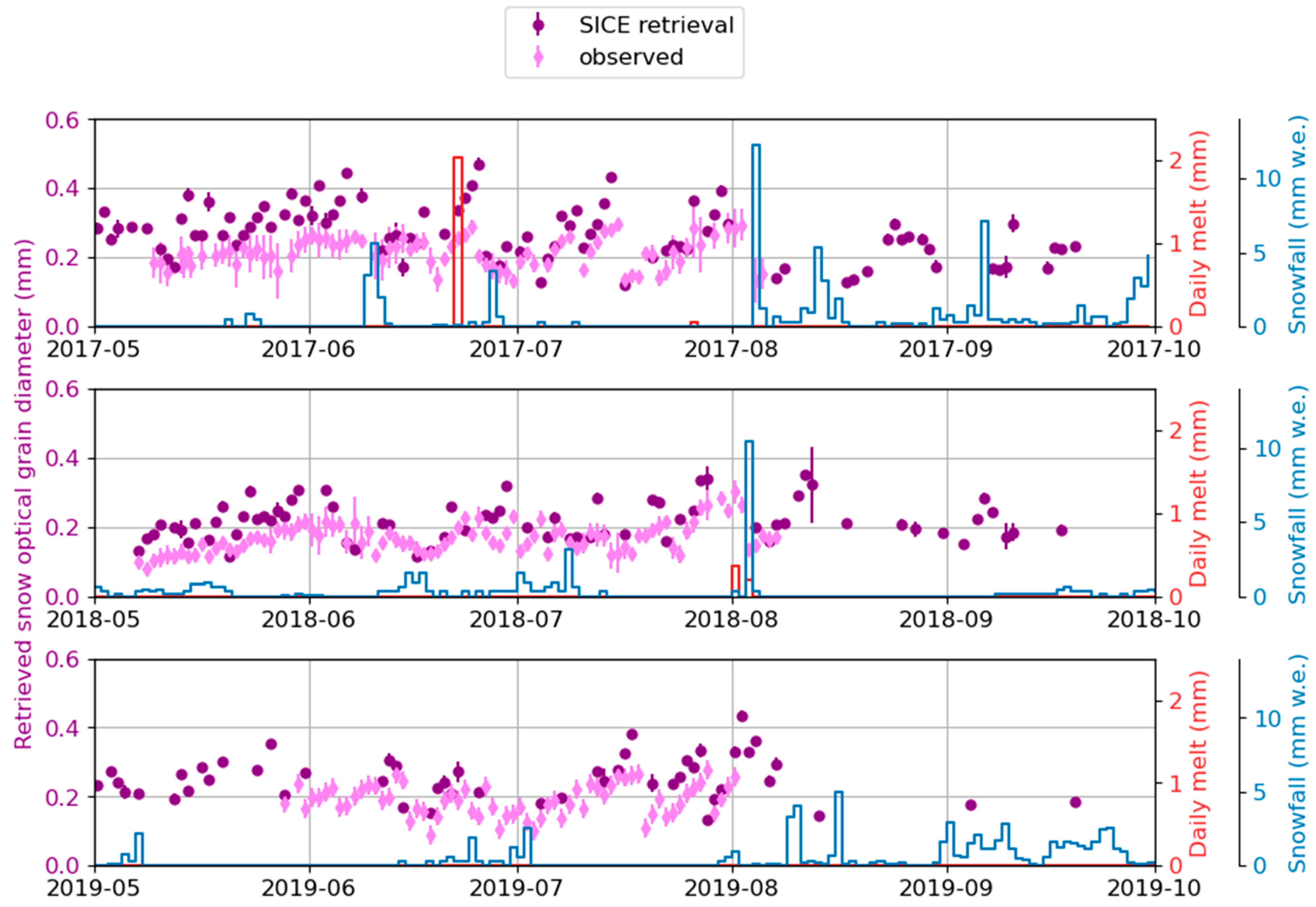
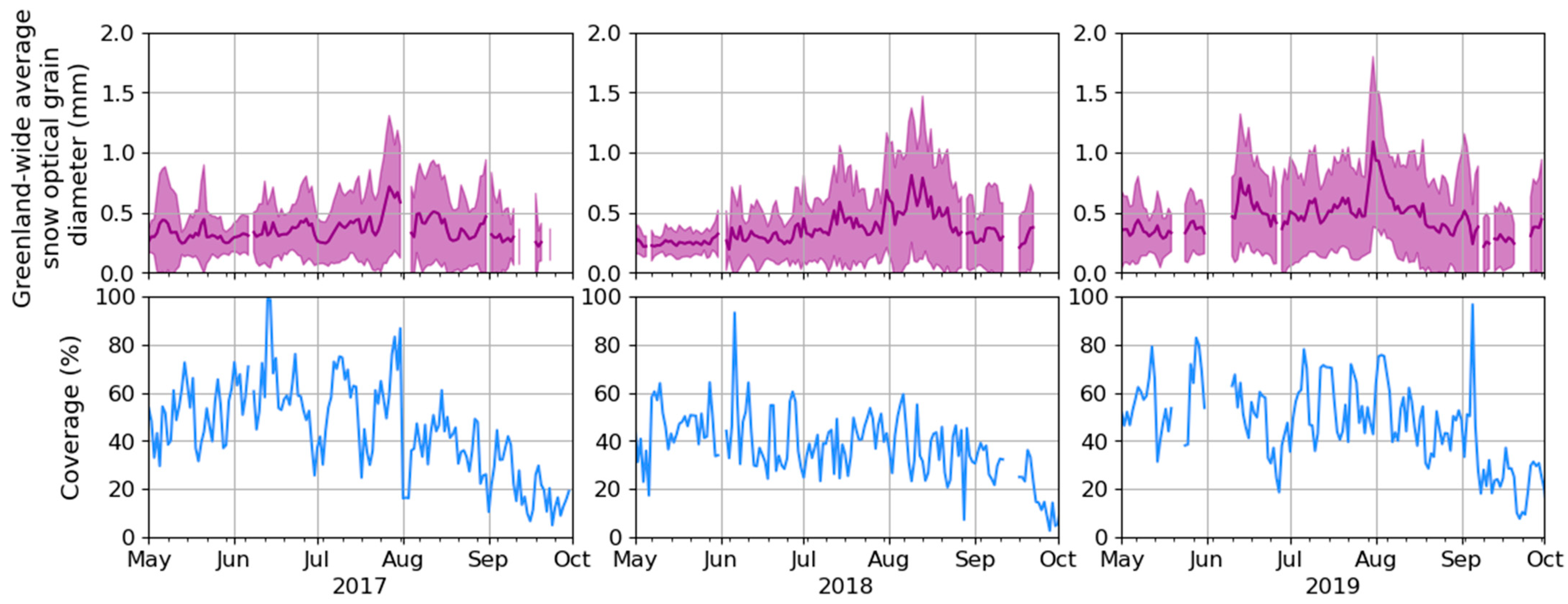
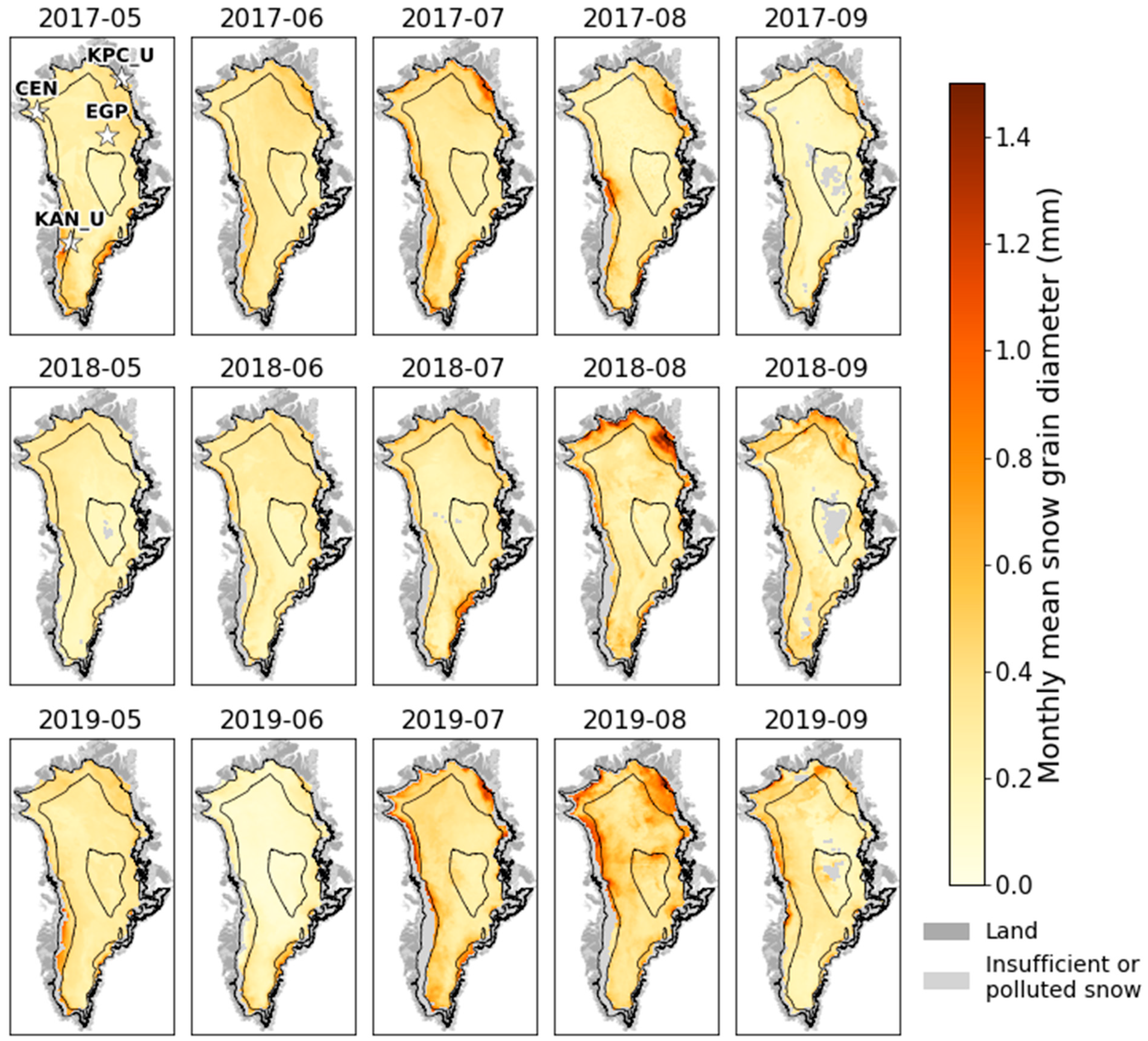
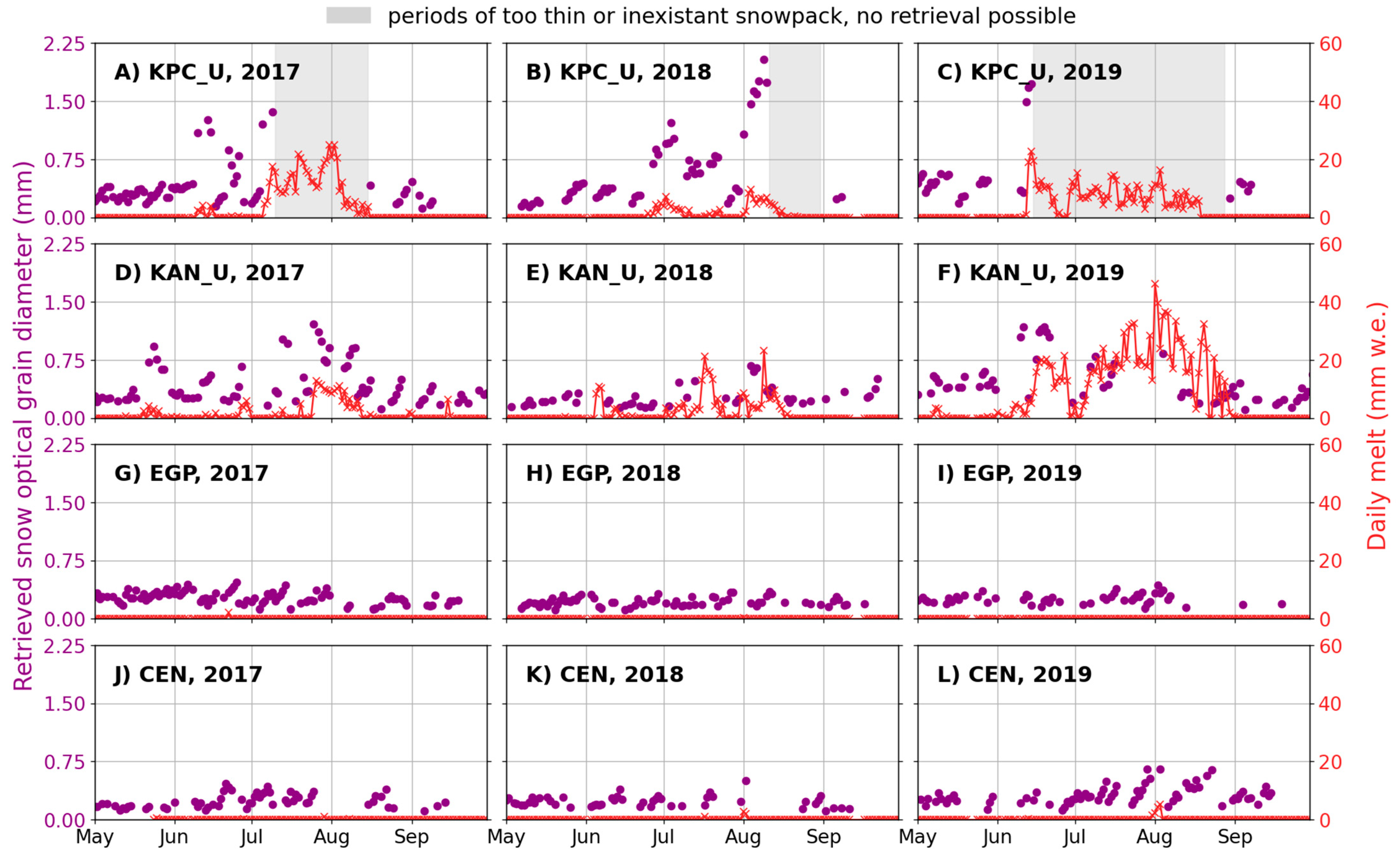
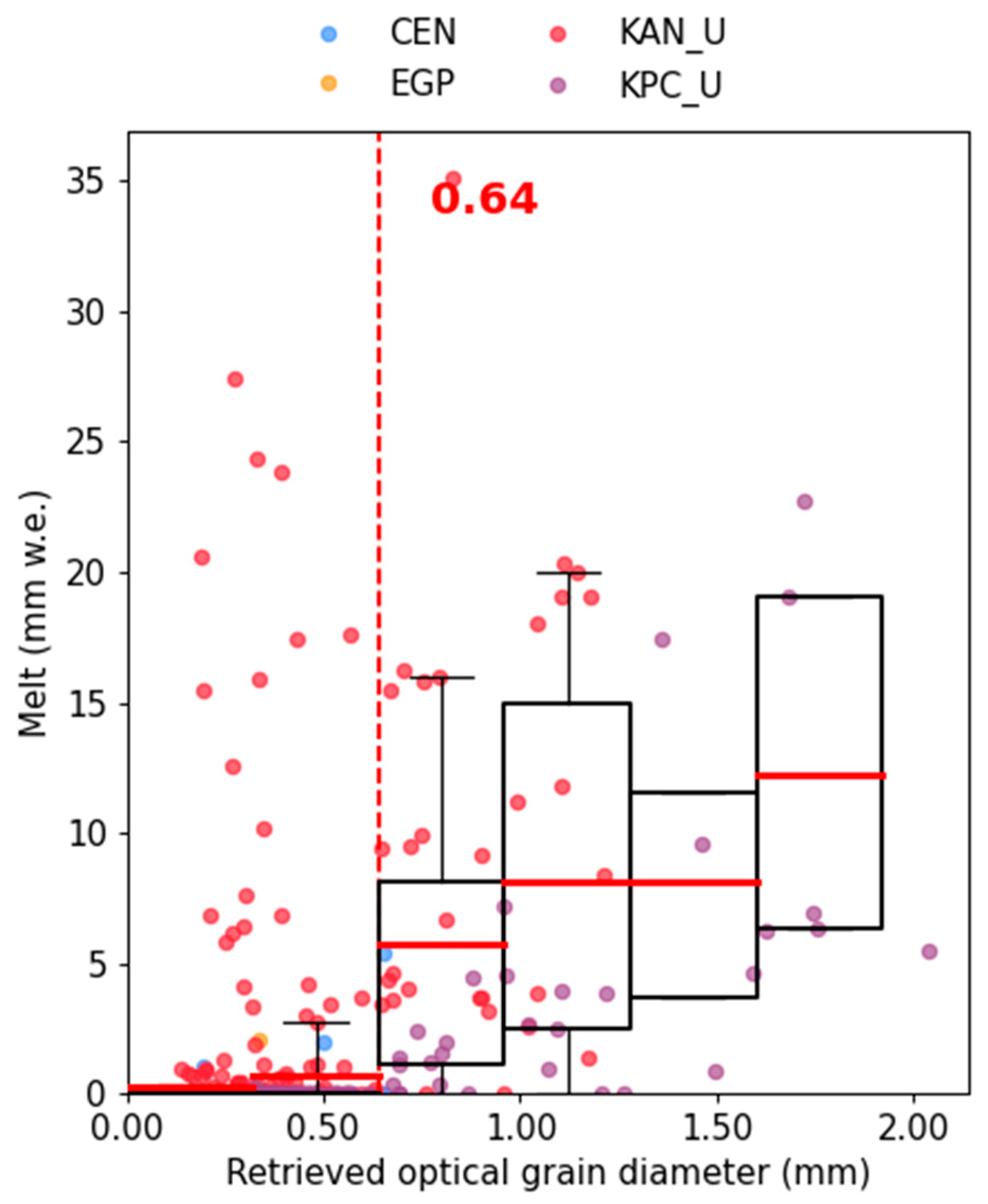
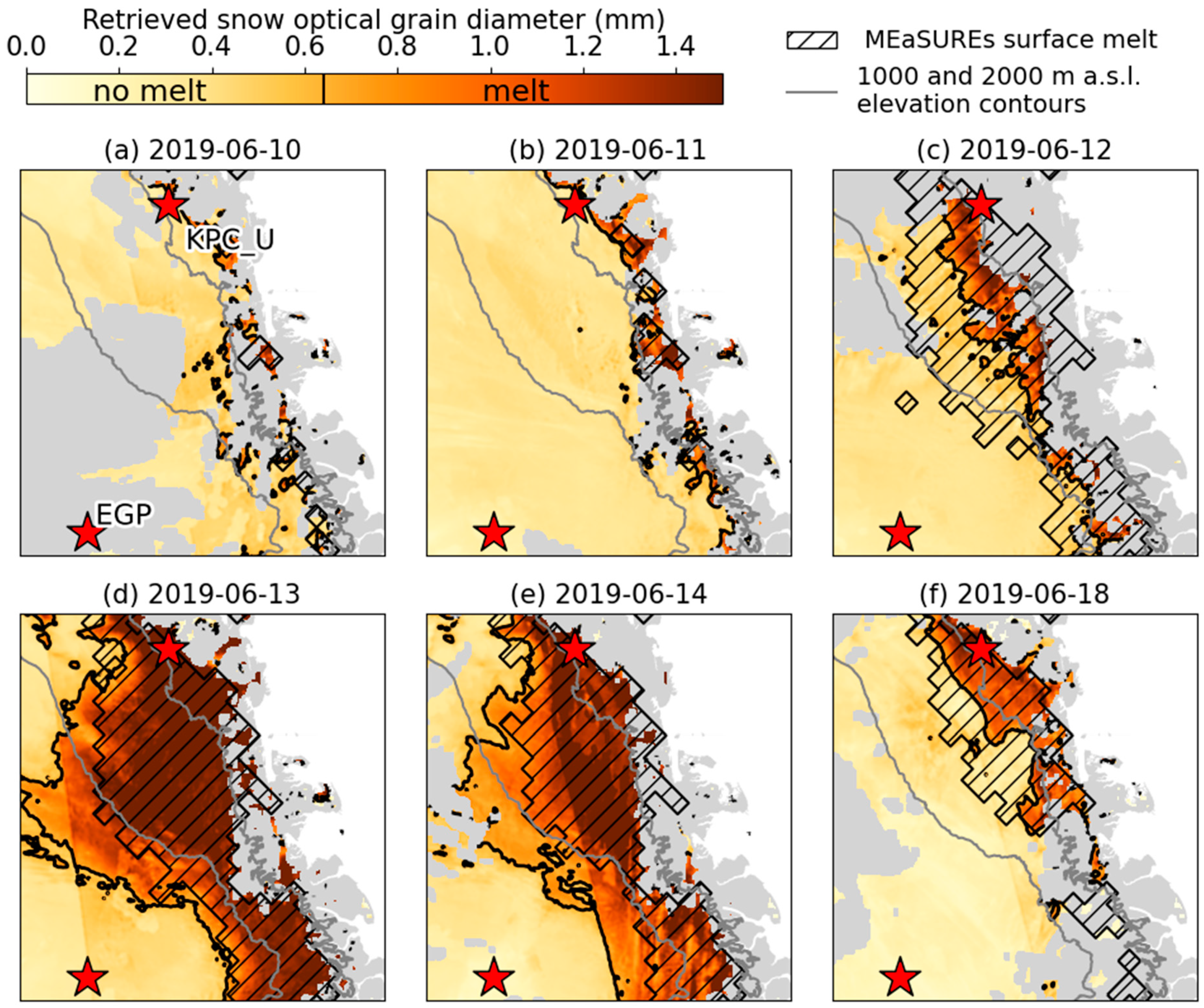
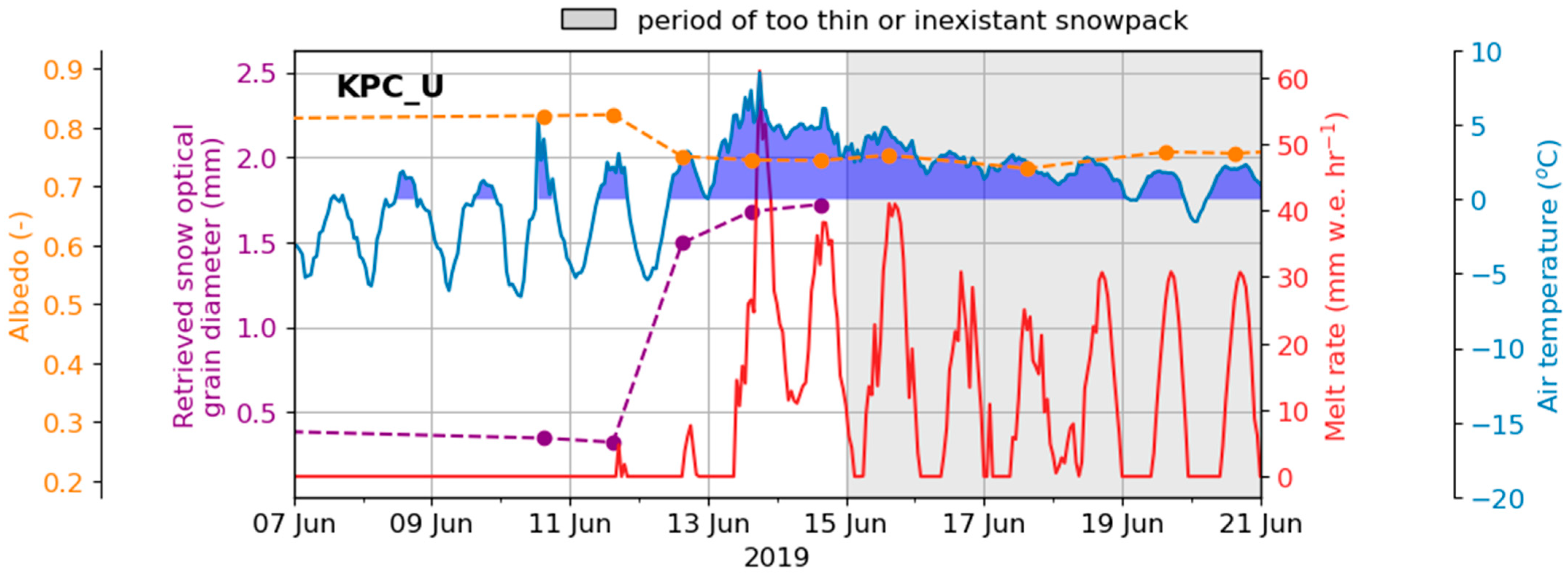

| Station | Latitude (deg. N) | Longitude (deg. E) | Elevation (m a.s.l.) |
|---|---|---|---|
| KAN_U | 67.0003 | −47.0243 | 1840 |
| KPC_U | 79.8345 | −25.1665 | 870 |
| EGP | 75.6247 | −35.9748 | 2700 |
| CEN | 77.1826 | −61.1127 | 1886 |
| Year | MD (mm) | RMSD (mm) | r | N |
|---|---|---|---|---|
| all | 0.06 | 0.17 | 0.68 | 145 |
| 2017 | 0.07 | 0.20 | 0.62 | 59 |
| 2018 | 0.05 | 0.14 | 0.59 | 57 |
| 2019 | 0.05 | 0.16 | 0.50 | 29 |
| MEaSUREs Melt Flag | Melt Flag | |||||||
|---|---|---|---|---|---|---|---|---|
| Year | Coverage (%) | Accuracy (%) | Omission Error (%) | Commission Error (%) | Coverage (%) | Accuracy (%) | Omission Error (%) | Commission Error (%) |
| 2017 | 99.2 | 77.7 | 65.6 | 6.7 | 51.6 | 90.5 | 27.8 | 2.2 |
| 2018 | 94.3 | 82.6 | 26.8 | 12.2 | 31.1 | 76.3 | 81.8 | 0 |
| 2019 | 98.4 | 63.3 | 56.4 | 0 | 52.5 | 60.9 | 53.2 | 0 |
| All | 97.3 | 74.4 | 50.3 | 7.3 | 45.1 | 75.8 | 51.3 | 1.1 |
Publisher’s Note: MDPI stays neutral with regard to jurisdictional claims in published maps and institutional affiliations. |
© 2022 by the authors. Licensee MDPI, Basel, Switzerland. This article is an open access article distributed under the terms and conditions of the Creative Commons Attribution (CC BY) license (https://creativecommons.org/licenses/by/4.0/).
Share and Cite
Vandecrux, B.; Box, J.E.; Wehrlé, A.; Kokhanovsky, A.A.; Picard, G.; Niwano, M.; Hörhold, M.; Faber, A.-K.; Steen-Larsen, H.C. The Determination of the Snow Optical Grain Diameter and Snowmelt Area on the Greenland Ice Sheet Using Spaceborne Optical Observations. Remote Sens. 2022, 14, 932. https://doi.org/10.3390/rs14040932
Vandecrux B, Box JE, Wehrlé A, Kokhanovsky AA, Picard G, Niwano M, Hörhold M, Faber A-K, Steen-Larsen HC. The Determination of the Snow Optical Grain Diameter and Snowmelt Area on the Greenland Ice Sheet Using Spaceborne Optical Observations. Remote Sensing. 2022; 14(4):932. https://doi.org/10.3390/rs14040932
Chicago/Turabian StyleVandecrux, Baptiste, Jason E. Box, Adrien Wehrlé, Alexander A. Kokhanovsky, Ghislain Picard, Masashi Niwano, Maria Hörhold, Anne-Katrine Faber, and Hans Christian Steen-Larsen. 2022. "The Determination of the Snow Optical Grain Diameter and Snowmelt Area on the Greenland Ice Sheet Using Spaceborne Optical Observations" Remote Sensing 14, no. 4: 932. https://doi.org/10.3390/rs14040932
APA StyleVandecrux, B., Box, J. E., Wehrlé, A., Kokhanovsky, A. A., Picard, G., Niwano, M., Hörhold, M., Faber, A.-K., & Steen-Larsen, H. C. (2022). The Determination of the Snow Optical Grain Diameter and Snowmelt Area on the Greenland Ice Sheet Using Spaceborne Optical Observations. Remote Sensing, 14(4), 932. https://doi.org/10.3390/rs14040932








